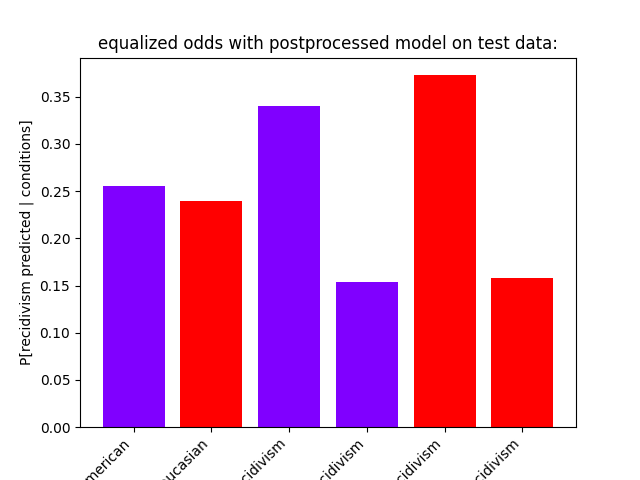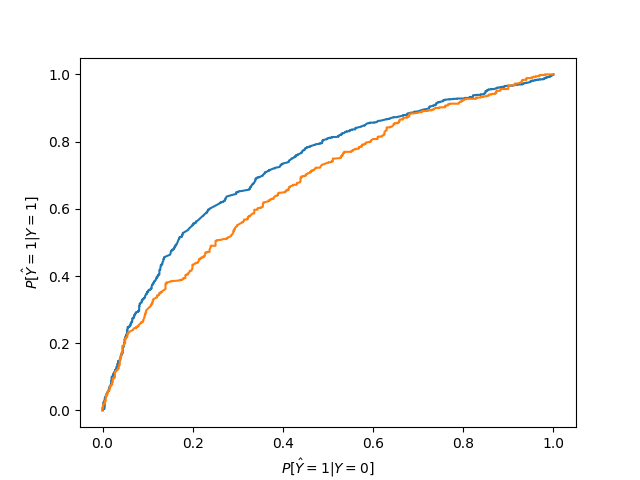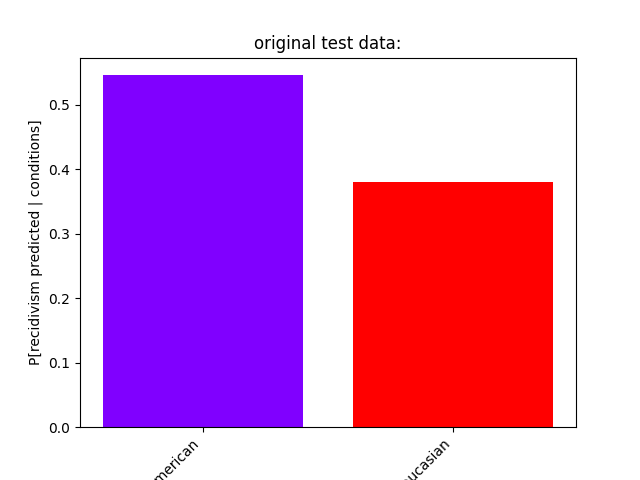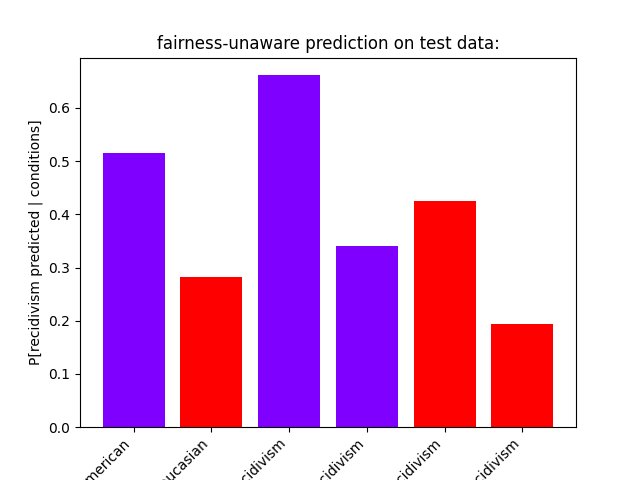Note
Click here to download the full example code
Binary Classification on COMPAS dataset¶
print(__doc__)
Getting and preparing the data¶
To demonstrate the post processing algorithm we use the “COMPAS” dataset from ProPublica. The labels represent the two-year recidivism ID, i.e. whether a person got rearrested within two years (label 1) or not (label 0). The features include sex, age, as well as information on prior incidents.
To start, let’s download the dataset using tempeh
import pandas as pd
import numpy as np
from tempeh.configurations import datasets
compas_dataset = datasets["compas"]()
X_train, X_test = compas_dataset.get_X(format=pd.DataFrame)
y_train, y_test = compas_dataset.get_y(format=pd.Series)
(
sensitive_features_train,
sensitive_features_test,
) = compas_dataset.get_sensitive_features("race", format=pd.Series)
X_train.loc[0], y_train[0]
Out:
(age 25.000000
juv_fel_count 0.000000
juv_misd_count -2.340451
juv_other_count 1.000000
priors_count -15.010999
age_cat_25 - 45 1.000000
age_cat_Greater than 45 0.000000
age_cat_Less than 25 0.000000
c_charge_degree_F 0.000000
c_charge_degree_M 1.000000
Name: 0, dtype: float64, 1.0)
Create a fairness-unaware model¶
First we set up a helper function that will help in analyzing the dataset as well as predictions from our models. Feel free to skip to the next cell for the actual logic.
import matplotlib.pyplot as plt
import matplotlib.cm as cm
# show_proportions is only a helper function for plotting
def show_proportions(
X, sensitive_features, y_pred, y=None, description=None, plot_row_index=1
):
print("\n" + description)
plt.figure(plot_row_index)
plt.title(description)
plt.ylabel("P[recidivism predicted | conditions]")
indices = {}
positive_indices = {}
negative_indices = {}
recidivism_count = {}
recidivism_pct = {}
groups = np.unique(sensitive_features.values)
n_groups = len(groups)
max_group_length = max([len(group) for group in groups])
color = cm.rainbow(np.linspace(0, 1, n_groups))
x_tick_labels_basic = []
x_tick_labels_by_label = []
for index, group in enumerate(groups):
indices[group] = sensitive_features.index[sensitive_features == group]
recidivism_count[group] = sum(y_pred[indices[group]])
recidivism_pct[group] = recidivism_count[group] / len(indices[group])
print(
"P[recidivism predicted | {}] {}= {}".format(
group, " " * (max_group_length - len(group)), recidivism_pct[group]
)
)
plt.bar(index + 1, recidivism_pct[group], color=color[index])
x_tick_labels_basic.append(group)
if y is not None:
positive_indices[group] = sensitive_features.index[
(sensitive_features == group) & (y == 1)
]
negative_indices[group] = sensitive_features.index[
(sensitive_features == group) & (y == 0)
]
prob_1 = sum(y_pred[positive_indices[group]]) / len(positive_indices[group])
prob_0 = sum(y_pred[negative_indices[group]]) / len(negative_indices[group])
print(
"P[recidivism predicted | {}, recidivism] {}= {}".format(
group, " " * (max_group_length - len(group)), prob_1
)
)
print(
"P[recidivism predicted | {}, no recidivism] {}= {}".format(
group, " " * (max_group_length - len(group)), prob_0
)
)
plt.bar(n_groups + 1 + 2 * index, prob_1, color=color[index])
plt.bar(n_groups + 2 + 2 * index, prob_0, color=color[index])
x_tick_labels_by_label.extend(
["{} recidivism".format(group), "{} no recidivism".format(group)]
)
x_tick_labels = x_tick_labels_basic + x_tick_labels_by_label
plt.xticks(
range(1, len(x_tick_labels) + 1),
x_tick_labels,
rotation=45,
horizontalalignment="right",
)
To get started we look at a very basic Logistic Regression model. We fit it to the training data and plot some characteristics of training and test data as well as the predictions of the model on those datasets.
We notice a stark contrast in the predictions with African-Americans being a lot more likely to be predicted to reoffend, similar to the original training data. However, there’s even a disparity between the subgroup of African-Americans and Caucasians with recidivism. When considering only the samples labeled with “no recidivism” African-Americans are much more likely to be predicted to reoffend than Caucasians. The test data shows a similar disparity.
from sklearn.linear_model import LogisticRegression
estimator = LogisticRegression(solver="liblinear")
estimator.fit(X_train, y_train)
print and plot data from training and test set as well as predictions with fairness-unaware classifier on both sets show only test data related plots by default - uncomment the next two lines to see training data plots as well
# show_proportions(X_train, sensitive_features_train, y_train,
# description="original training data:", plot_row_index=1)
# show_proportions(X_train, sensitive_features_train,
# estimator.predict(X_train), y_train,
# description="fairness-unaware prediction on training data:",
# plot_row_index=2)
show_proportions(
X_test,
sensitive_features_test,
y_test,
description="original test data:",
plot_row_index=3,
)
show_proportions(
X_test,
sensitive_features_test,
estimator.predict(X_test),
y_test,
description="fairness-unaware prediction on test data:",
plot_row_index=4,
)
plt.show()
Out:
original test data:
P[recidivism predicted | African-American] = 0.5457198443579766
P[recidivism predicted | Caucasian] = 0.3795518207282913
fairness-unaware prediction on test data:
P[recidivism predicted | African-American] = 0.5155642023346303
P[recidivism predicted | African-American, recidivism] = 0.661319073083779
P[recidivism predicted | African-American, no recidivism] = 0.3404710920770878
P[recidivism predicted | Caucasian] = 0.2815126050420168
P[recidivism predicted | Caucasian, recidivism] = 0.42435424354243545
P[recidivism predicted | Caucasian, no recidivism] = 0.19413092550790068
Postprocessing the model to get a fair model¶
The idea behind postprocessing is to alter the output of the fairness-unaware model to achieve fairness. The postprocessing algorithm requires three input arguments: - the matrix of samples X - the vector of predictions y from the fairness-unaware model - the vector of group attribute values A (in the code we refer to it as sensitive_features)
The goal is to make the output fair with respect to constraints. The postprocessing algorithm uses one of
Demographic Parity (DP): \(P\ [\ h(X)=\hat{y}\ |\ A=a] = P\ [\ h(X)=\hat{y}\ ] \qquad \forall a, \hat{y}\)
Equalized Odds (EO): \(P\ [\ h(X)=\hat{y}\ |\ A=a, Y=y] = P\ [\ h(X)=\hat{y}\ |\ Y=y\ ] \qquad \forall a, \hat{y}\)
where \(h(X)\) is the prediction based on the input \(X\), \(\hat{y}\) and \(y\) are labels, and \(a\) is a sensitive feature value. In this example, we’d expect the postprocessed model with DP to be balanced between races. In this particular scenario it makes more sense to aim at fairness through accuracy like EO. EO does not make the same guarantees. Instead, it ensures parity between the subgroups of each race with label 1 in the training set, and parity between the subgroups of each race with label 0 in the training set. Applied to this scenario, this means that the subgroups of each race who reoffended in the past are equally likely to be predicted to reoffend (and therefore also equally likely not to). Similarly, there is parity between subgroups of each race without recidivism, but we have no parity between the groups with different training labels. In mathematical terms at the example of African-American and Caucasian:
but that also means that African-Americans (and Caucasians) of different subgroup based on training labels don’t necessarily have parity:
Assessing which disparity metric is indeed fair varies by application scenario. In this case the evaluation focuses on Equalized Odds, because the recidivism prediction should be accurate for each race, and for each subgroup within. The plot for the training data shows the intended outcome, while the plot for the test data exhibits slight variation which is likely due to randomized predictions as well as a slightly different data distribution.
This wrapper around the unconstrained estimator serves the purpose of mapping
the predict method to predict_proba` so that we can use real values to get
more accurate estimates.
from sklearn import clone
from sklearn.base import BaseEstimator, ClassifierMixin
from sklearn.utils.validation import check_is_fitted
from sklearn.exceptions import NotFittedError
class LogisticRegressionAsRegression(BaseEstimator, ClassifierMixin):
def __init__(self, logistic_regression_estimator):
self.logistic_regression_estimator = logistic_regression_estimator
def fit(self, X, y):
try:
check_is_fitted(self.logistic_regression_estimator)
self.logistic_regression_estimator_ = self.logistic_regression_estimator
except NotFittedError:
self.logistic_regression_estimator_ = clone(
self.logistic_regression_estimator
).fit(X, y)
return self
def predict(self, X):
# use predict_proba to get real values instead of 0/1, select only prob for 1
scores = self.logistic_regression_estimator_.predict_proba(X)[:, 1]
return scores
from fairlearn.postprocessing import ThresholdOptimizer
estimator_wrapper = LogisticRegressionAsRegression(estimator).fit(X_train, y_train)
postprocessed_predictor_EO = ThresholdOptimizer(
estimator=estimator_wrapper, constraints="equalized_odds", prefit=True
)
postprocessed_predictor_EO.fit(
X_train, y_train, sensitive_features=sensitive_features_train
)
fairness_aware_predictions_EO_train = postprocessed_predictor_EO.predict(
X_train, sensitive_features=sensitive_features_train
)
fairness_aware_predictions_EO_test = postprocessed_predictor_EO.predict(
X_test, sensitive_features=sensitive_features_test
)
# show only test data related plot by default - uncomment the next line to see
# training data plot as well
# show_proportions(
# X_train, sensitive_features_train, fairness_aware_predictions_EO_train,
# y_train,
# description="equalized odds with postprocessed model on training data:",
# plot_row_index=1)
show_proportions(
X_test,
sensitive_features_test,
fairness_aware_predictions_EO_test,
y_test,
description="equalized odds with postprocessed model on test data:",
plot_row_index=2,
)
plt.show()

Out:
equalized odds with postprocessed model on test data:
P[recidivism predicted | African-American] = 0.25583657587548636
P[recidivism predicted | African-American, recidivism] = 0.3404634581105169
P[recidivism predicted | African-American, no recidivism] = 0.15417558886509636
P[recidivism predicted | Caucasian] = 0.23949579831932774
P[recidivism predicted | Caucasian, recidivism] = 0.3726937269372694
P[recidivism predicted | Caucasian, no recidivism] = 0.1580135440180587
Post Processing in Detail¶
While this worked as the numbers show, it’s not entirely obvious how it found its solution. The following section will provide a deep dive on post processing for Equalized Odds (EO).
The post processing method (based on work by Hardt, Price, Srebro) takes a fairness-unaware model and disparity constraints (such as EO) in the constructor and features (X), labels (y), and a sensitive feature (sensitive_features) in the fit method. It subsequently uses the model to make predictions for all samples in X. Note that these predictions could be 0/1 (as in this example), or more categories, or even real valued scores. In this case, this looks as follows:
Out:
array([0.08207579, 0.43139474, 0.54704338, ..., 0.5663099 , 0.2746925 ,
0.37253929])
Finding threshold rules¶
The algorithm then tries to find all thresholding rules with which it could divide the data. Any score for which the thresholding rule evaluates to true is predicted to be 1. It does that for each group, so in this case for each race. Depending on the unconstrained predictor’s scores you could have lots of thresholding rules, between each set of such values. For each rule we just evaluate the following two probabilities empirically:
The former is the false negative rate (of that group), while the latter is the true positive rate (of that group). In this example, the threshold rules would be the ones shown below:
from fairlearn.postprocessing._threshold_optimizer import _reformat_and_group_data
data_grouped_by_sensitive_feature = _reformat_and_group_data(
sensitive_features_train, y_train.astype(int), scores
)
data_grouped_by_sensitive_feature.describe()
from fairlearn.postprocessing._roc_curve_utilities import _calculate_roc_points
roc_points = {}
for group_name, group in data_grouped_by_sensitive_feature:
roc_points[group_name] = _calculate_roc_points(
data_grouped_by_sensitive_feature.get_group(group_name), 0
)
print("Thresholding rules:")
roc_points
Out:
Thresholding rules:
{'African-American': x ... operation
0 0.000000 ... [>inf]
1 0.000000 ... [>0.9900687636639462]
2 0.000000 ... [>0.9833277651688408]
3 0.000000 ... [>0.9769547709302975]
4 0.000000 ... [>0.9759584558991194]
... ... ... ...
1325 0.997135 ... [>0.07782828780556121]
1326 0.998090 ... [>0.07110773039018758]
1328 0.999045 ... [>0.0628409225957082]
1329 0.999045 ... [>0.049301185293287406]
1330 1.000000 ... [>-inf]
[1331 rows x 3 columns], 'Caucasian': x ... operation
0 0.000000 ... [>inf]
1 0.000000 ... [>0.9900788571796195]
2 0.000000 ... [>0.9841750223687503]
3 0.000000 ... [>0.9777093594991544]
4 0.000000 ... [>0.970539859957543]
.. ... ... ...
885 0.995227 ... [>0.06951543060753071]
886 0.996420 ... [>0.06209095551282254]
887 0.997613 ... [>0.04704292461740367]
888 0.998807 ... [>0.020606227673374417]
889 1.000000 ... [>-inf]
[890 rows x 3 columns]}
The base points with (x,y) as (0,0) and (1,1) always exist, because that essentially just means that we’re predicting everything as 0 or everything as 1 regardless of the scores from the fairness-unaware model. Let’s look at both cases:
x=0, y=0, threshold rule “>inf”: more than infinity is impossible, which means every sample is predicted as 0. That means \(P[\hat{Y} = 1 | Y = 0] = 0\) (represented as x) because the predictions \(\hat{Y}\) are never 1, and similarly \(P[\hat{Y} = 1 | Y = 1] = 0\) (represented as y).
x=1, y=1, threshold rule “>-inf”: more than infinity is always true, which means every sample is predicted as 1. That means \(P[\hat{Y} = 1 | Y = 0] = 1\) (represented as x) because the predictions \(\hat{Y}\) are always 1, and similarly \(P[\hat{Y} = 1 | Y = 1] = 1\) (represented as y).
The more interesting logic happens in between. The x and y values were calculated as follows:
n_group_0 = {}
n_group_1 = {}
for group_name, group in data_grouped_by_sensitive_feature:
print("{}:".format(group_name))
n_group_1[group_name] = sum(group["label"])
n_group_0[group_name] = len(group) - n_group_1[group_name]
print(" number of samples with label 1: {}".format(n_group_1[group_name]))
print(" number of samples with label 0: {}".format(n_group_0[group_name]))
threshold = 0.5
for group_name, group in data_grouped_by_sensitive_feature:
x_group_0_5 = (
sum((group["score"] > threshold) & (group["label"] == 0))
/ n_group_0[group_name]
)
y_group_0_5 = (
sum((group["score"] > threshold) & (group["label"] == 1))
/ n_group_1[group_name]
)
print("{}:".format(group_name))
print(" P[Ŷ = 1 | Y = 0] = {}".format(x_group_0_5))
print(" P[Ŷ = 1 | Y = 1] = {}".format(y_group_0_5))
Out:
African-American:
number of samples with label 1: 1100
number of samples with label 0: 1047
Caucasian:
number of samples with label 1: 551
number of samples with label 0: 838
African-American:
P[Ŷ = 1 | Y = 0] = 0.3390639923591213
P[Ŷ = 1 | Y = 1] = 0.6845454545454546
Caucasian:
P[Ŷ = 1 | Y = 0] = 0.18377088305489261
P[Ŷ = 1 | Y = 1] = 0.4029038112522686
Note that it never makes sense to have \(x>y\) because in that case you’re better off flipping labels, i.e. completely turning around the meaning of the scores. The method automatically does that unless specified otherwise.
Interpolated Predictions and Probabilistic Classifiers¶
This way you end up with a set of points above the diagonal line connecting (0,0) and (1,1). We calculate the convex hull based on that, because we can reach any point in between two known thresholding points by interpolation. An interpolation could be \(p_0 (x_0, y_0) + p_1 (x_1, y_1)\). For the post processing algorithm that would mean that we use the rule defined by \((x_0, y_0, \text{operation}_0)\) \(\quad p_0\) percent of the time, and the rule defined by \((x_1, y_1, \text{operation}_1)\) \(\quad p_1\) percent of the time, thus resulting in a probabilistic classifier. Depending on the data certain fairness objectives can only be accomplished with probabilistic classifiers. However, not every use case lends itself to probabilistic classifiers, since it could mean that two people with identical features are classified differently.
Finding the Equalized Odds solution¶
From all the ROC points (see below) we need to extract the convex hull for both groups/curves.
for group_name, group in data_grouped_by_sensitive_feature:
plt.plot(roc_points[group_name].x, roc_points[group_name].y)
plt.xlabel("$P [ \\hat{Y}=1 | Y=0 ]$")
plt.ylabel("$P [ \\hat{Y}=1 | Y=1 ]$")
plt.show()

In the Equalized Odds case, we need to find a point where the presented probabilities (false positive rate, true positive rate, and thereby also true negative rate and false negative rate) for the corresponding groups match while minimizing the error, which is equivalent to finding the minimum error overlap of the convex hulls of the ROC curves. The error in the chart is smallest in the top left corner. This is done as part of the fit step above, and we’ll repeat it here for completeness. The yellow area is the overlap between the areas under the curve that are reachable with interpolation for both groups. Of course, this works for more than two groups as well. The result is that we have interpolated solutions for each group, i.e. every prediction is calculated as the weighted result of two threshold rules.
In this particular case the Caucasian curve is always below or matching the African-American curve. That means that the area under the Caucasian curve is also identical to the overlap. That does not always happen, though, and overlaps can be fairly complex with multiple intersecting curves defining its outline.
We can actually even look up the specific interpolations and interpret the results. Keep in mind that these interpolations come up with a floating point number between 0 and 1, and represent the probability of getting 0 or 1 in the predicted outcome.
The result for African-Americans is a combination of two thresholding rules. The first rule checks whether the score is above 0.542, the other whether it is above 0.508. The first rule has a weight of 0.19, which means it determines 19% of the resulting probability. The second rule determines the remaining 81%. In the chart the Caucasian curve is below the African-American curve at the EO solution. This means that there is a slight adjustment according to the formula presented below.
The Caucasian rules have somewhat lower thresholds: The first rule’s threshold is >0.421 and it is basically the deciding factor with a weight of 99.3%, while the second rule’s threshold is >0.404.
Overall, this means that the postprocessing algorithm learned to get probabilities consistent with Equalized Odds and minimal error by setting lower thresholds for Caucasians than for African-Americans. The resulting probability from the formula below is then the probability to get label 1 from the probabilistic classifier.
Note that this does not necessarily mean it’s fair. It simply enforced the constraints we asked it to enforce, as described by Equalized Odds. The societal context plays a crucial role in determining whether this is fair.
The parameters p_ignore and prediction_constant are irrelevant for cases where the curves intersect in the minimum error point. When that doesn’t happen, and the minimum error point is only part of one curve, then the interpolation is adjusted as follows:
p_ignore * prediction_constant + (1 - p_ignore) * (p0 * operation0(score) + p1 * operation1(score))
The adjustment should happen to the higher one of the curves and essentially brings it closer to the diagonal as represented by prediction_constant. In this case this is not required since the curves intersect, but we are actually slightly inaccurate because we only determine the minimum error point on a grid of x values, instead of calculating the intersection point analytically. By choosing a large grid_size this can be alleviated.
postprocessed_predictor_EO._plot = True
postprocessed_predictor_EO.fit(
X_train, y_train, sensitive_features=sensitive_features_train
)
for (
group,
interpolation,
) in postprocessed_predictor_EO._post_processed_predictor_by_sensitive_feature.items():
print("{}:".format(group))
print("\n ".join(interpolation.__repr__().split(",")))
print("-----------------------------------")
Out:
African-American:
[p_ignore: 0.26151601889416654
prediction_constant: 0.14200000000000002
p0: 0.8378857142857137
operation0: [>0.5825603754888381]
p1: 0.16211428571428632
operation1: [>0.5665583358247704]]
-----------------------------------
Caucasian:
[p_ignore: 0.0
prediction_constant: 0.14200000000000002
p0: 0.0019999999999962322
operation0: [>0.5189601859111345]
p1: 0.9980000000000038
operation1: [>0.51707025208793]]
-----------------------------------
Total running time of the script: ( 0 minutes 3.021 seconds)

